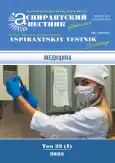Development and approbation of an analytical method for the quantitative determination of carbon tetrachloride in freons used in the composition of medicines in the form of an aerosol
- Authors: Selyutin O.A.1, Shatalov D.O.1, Pisarev D.I.2, Novikov O.O.2, Zhilyakova E.T.3, Chichulina V.V.1
-
Affiliations:
- MIREA – Russian Technological University
- RUDN University
- Belgorod State National Research University
- Issue: Vol 23, No 1 (2023)
- Pages: 41-46
- Section: PHARMACEUTICAL CHEMISTRY, PHARMACOGNOSY
- URL: https://bakhtiniada.ru/2410-3764/article/view/126192
- DOI: https://doi.org/10.55531/2072-2354.2023.23.1.41-46
- ID: 126192
Cite item
Full Text
Abstract
Aim – to develop and test an analytical method for the quantitative determination of carbon tetrachloride in freons used in the composition of medicines in the form of an aerosol.
Material and methods. Carbon tetrachloride (tetrachloromethane, Freon-10) - CCl4, M.m. = 153.81, heavy, colorless, volatile liquid with a sweet smell reminiscent of chloroform. Melting point - 22.96 °С, boiling point - 76.75 °C, relative density at 20 ° - [d]420 1.595. Poorly soluble in water (0.5 g/l), unrestrictedly miscible with alcohol, ether, acetone, benzene (chemically pure grade).
To determine the tests for the presence and quantitative determination of carbon tetrachloride in propellant gases used in medicinal preparations, we chose the drug "Salbutamol-Pharmstandard". To identify and quantify carbon tetrachloride in propellants used in medicinal products, the gas-liquid chromatography method with electron capture detection with a capillary column was applied.
Results. The developed method was used to determine carbon tetrachloride in the test preparation "Salbutamol". The results were statistically processed and showed that the content of carbon tetrachloride in the test preparation was 0.0158±0.0007 mg/l. The error of a single experiment with a confidence probability P = 95% was 4.42%
Conclusion. We proposed a method for estimating the content of carbon tetrachloride impurities in aerosol dosage forms by gas-liquid chromatography with an electron capture detector. The technique involved the gas chromatographic separation of a sample, taken from an aerosol can, on a capillary chromatographic column. The most appropriate detector in this case turned out to be an electron capture detector.
Keywords
Full Text
##article.viewOnOriginalSite##About the authors
Oleg A. Selyutin
MIREA – Russian Technological University
Author for correspondence.
Email: selutinoa@yandex.ru
ORCID iD: 0000-0001-5825-1337
External PhD Student of the Department of Biotechnology and Industrial Pharmacy
Russian Federation, MoscowDenis O. Shatalov
MIREA – Russian Technological University
Email: shat-05@mail.ru
ORCID iD: 0000-0003-4510-1721
PhD, Associate Professor of the Department of Biotechnology and Industrial Pharmacy
Russian Federation, MoscowDmitry I. Pisarev
RUDN University
Email: juniper05@mail.ru
ORCID iD: 0000-0002-2996-7712
PhD, Associate Professor
Russian Federation, MoscowOleg O. Novikov
RUDN University
Email: ole9222@yandex.ru
ORCID iD: 0000-0002-7038-9803
PhD, Professor, Deputy Director of the RERC "Pharmacy" for Scientific and Educational Work
Russian Federation, MoscowElena T. Zhilyakova
Belgorod State National Research University
Email: ezhilyakova@bsu.edu.ru
ORCID iD: 0000-0002-8685-1601
PhD, Professor, Head of the Department of Pharmaceutical Technology
Russian Federation, BelgorodVictoriya V. Chichulina
MIREA – Russian Technological University
Email: murzilka991@gmail.com
ORCID iD: 0000-0002-2701-3309
Student of the Department of Biotechnology and Industrial Pharmacy
Russian Federation, MoscowReferences
- Bogdanova VD. The problem of the formation of organochlorine compounds during the disinfection of water from unprotected underground sources. In: Hygienic science – the path to public health. 2020:23-34. (In Russ.). [Богданова В.Д. Проблема образования хлорорганических соединений при обеззараживании воды незащищенных подземных источников. В кн.: Гигиеническая наука – путь к здоровью населения. 2020:23-34].
- Kozvonin VA, Sazanov AV, Syrchina NV. Experimental confirmation of the hepatotoxic properties of carbon tetrachloride. Modern Science. 2019;10-2:27-32. (In Russ.). [Козвонин В.А., Сазанов А.В., Сырчина Н.В. Экспериментальное подтверждение гепатотоксических свойств четыреххлористого углерода. Modern Science. 2019;10-2:27-32].
- Ioutsi AN, Sumtsov MA, Artyushenko DA, et al. Applicability of Capillary Gas-Liquid Chromatography for Determination of Parabens in Pharmaceutical Analysis. The bulletin of the scientific centre for expert evaluation of medicinal products. 2019;9(2):123-130. (In Russ.). [Иоутси А.Н., Сумцов М.А., Артюшенко Д.А., и др. Возможность применения капиллярной газожидкостной хроматографии в фармацевтическом анализе при определении парабенов. Ведомости Научного центра экспертизы средств медицинского применения. 2019;9(2):123-130]. doi: 10.30895/1991-2919-2019-9-2-123-130
- Zabolotnaya E, Trokhin VE. Optimization of the process of performing chromatographic analysis of chemical reagents and highly pure substances based on the differentiation of effective analysis methods. In: Chemical technology and biotechnology of new materials and products. 2018:31-33. (In Russ.). [Заболотная Е., Трохин В.Е. Оптимизация процесса выполнения хроматографического анализа химических реактивов и особо чистых веществ на основе дифференцированности эффективных методик анализа. В кн.: Химическая технология и биотехнология новых материалов и продуктов. 2018:31-33].
- Saraji M, Javadian S. Single-drop microextraction combined with gas chromatography-electron capture detection for the determination of acrylamide in food samples. Food chemistry. 2019;274:55-60. doi: 10.1016/j.foodchem.2018.08.108
- Selyutin OA, Novikov OO, Pisarev DI. Development of methods for detecting and quantifying carbon tetrachloride in propellants used in finished dosage forms. In: Harmonization of Approaches to Pharmaceutical Development. 2020;60-62. (In Russ.). [Селютин О.А., Новиков О.О., Писарев Д.И. Разработка методик обнаружения и количественного определения четыреххлористого углерода в пропеллентах, используемых в составе готовых лекарственных форм. В кн.: Гармонизация подходов к фармацевтической разработке. 2020:60-62].
- Tomanovskaya VF, Kolotova BE. Freons. Properties and application. L., 1970. (In Russ.). [Томановская В.Ф., Колотова Б.Е. Фреоны. Свойства и применение. Л., 1970].
- Peters AN, Temnikova EYu, Bogomolov AR. Direction of research on the intensification of heat transfer processes in thermosyphons. In: Young Russia 2021;21111.1-21111.5. (In Russ.). [Петерс А.Н., Темникова Е.Ю., Богомолов А.Р. Направление исследований по интенсификации процессов переноса теплоты в термосифонах. В кн.: Россия молодая. 2021:21111.1-21111.5].
Supplementary files









